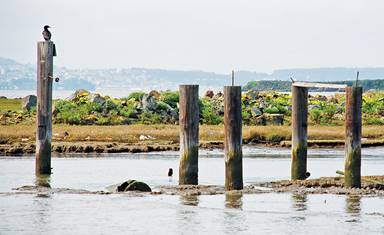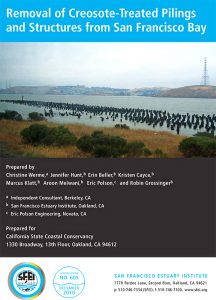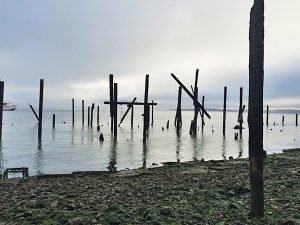|
| Creosote Cleanup: The San Francisco Bay’s Piling Problem
http://bayareamonitor.org/creosote-cleanup-the-san-francisco-bays-piling-problem/

The San Francisco Bay shoreline is rife with old wood pilings that contain creosote, which is toxic to marine life. Photo by Alec MacDonald.
By Robin Meadows
Pick just about any spot on the edge of the San Francisco Bay and you’ll probably see wood pilings poking out of the water. Driven deep into the Bay floor to support piers and other waterfront structures between the Gold Rush and the 1970s, the pilings are a reminder of our history. Today, birds pose on them picturesquely and, on a sunny day, the contrast of the dark wood against the blue water and sky is beautiful.
But the pilings also have a downside. “Creosote was slathered onto wood pilings to preserve them in the aquatic environment,” said Marilyn Latta, a project manager at the State Coastal Conservancy. Derived from coal tar, creosote contains polycyclic aromatic hydrocarbons and other chemicals that are toxic to marine life. Creosote-treated wood is now banned in new structures in the Bay.
Some creosote pilings are still in use but many were abandoned long ago. “These things are just falling apart — they’re degrading and falling into the Bay,” she added. They’re also still toxic. In a 2000 study, Bodega Marine Laboratory researchers showed that even 40-year-old pilings affected Pacific herring embryos in the laboratory. “The baby fish either don’t hatch or don’t thrive,” Latta explained.
Prized for their roe, herring are the only native fish that are currently harvested commercially in the Bay. These small, silvery fish spend most of the year in the ocean but migrate into the Bay during the winter to spawn, laying their eggs on hard surfaces. “They spawn out sticky eggs that attach to pilings,” Latta said. Natural sites for herring spawning include eelgrass beds; however, there isn’t much eelgrass left in the Bay today.
The conservancy is in the middle of the Bay’s first project to remove old pilings and restore herring habitat, funded by a $2 million grant from the National Fish and Wildlife Foundation. Piling demolition was completed last fall and habitat restoration will start this spring or summer. The final phase will include monitoring eelgrass growth and herring spawning to see how well it works.
The first step was choosing a project site, and the conservancy asked the San Francisco Estuary Institute (SFEI) to help.
Jennifer Hunt, a project manager at SFEI, was intrigued: “We were curious to learn more about pilings — I grew up on the coast and remember the smell of creosote on hot days.” SFEI also supported the mission. “Restoring the Bay to a more natural condition is always a positive thing,” Hunt said.
In 2010, SFEI mapped pilings and historical herring spawning grounds. “We wanted to identify as many pilings as we could, so we did it at low tide,” Hunt said. They found that more than 30,000 pilings — roughly half of those in the Bay — are derelict. Hot spots for dilapidated pilings include the San Francisco waterfront and Point Richmond, which are also places where herring
spawn or once spawned.

SFEI’s findings are detailed in the report Removal of Creosote-Treated Pilings and Structures from San Francisco Bay
The conservancy chose a 3.5-acre site on Point San Pablo in the City of Richmond, which was a hot spot for derelict pilings as well as a former herring spawning ground, making it a good candidate for eelgrass restoration.
Next the conservancy needed permits and approval from the Richmond City Council. “The Bay is a huge patchwork of public and private landowners on land and under water; the project required 10 or more permits from local, state, and federal agencies,” Latta said.
Craig Murray, a City of Richmond staffer, helped shepherd the project through the approval process. “The people of Richmond benefitted because the submerged lands had been identified as blighted, but there was no source of funds for cleanup,” he said, adding that the project could ultimately increase local shoreline access and extend the San Francisco Bay Trail.
The Richmond City Council approved the pilot project in May 2016. However, to avoid disrupting the seasons for salmon migration and bird nesting, the conservancy had to wait until fall for demolition. Pilings were seated as deep as 30 feet underground, and removal was well-orchestrated. “It seemed to take just minutes to set up and remove a piling — the backhoe plunged underwater to snip off a piling and then swung over to place it in a metal box,” Murray recalled, adding, “It was amazing to see the skill and dexterity of the crew working with all this equipment on the free-floating waters of San Pablo Bay.”
Ducks Unlimited, a nonprofit dedicated to conserving waterfowl habitat, helped handle the demolition, removing roughly 450 creosote pilings as well as concrete, metal, and other debris for an approximate total of 445 tons. The creosote debris was then shipped to the Potrero Hills Landfill, which is in Solano County on the edge of the Suisun Marsh.

Some of the pilings later removed by Ducks Unlimited as part of the conservancy’s project.
Since removing the pilings, the conservancy has had to wait again for the next step: restoration is scheduled for spring or summer to coincide with the eelgrass growing season. Subtidal restoration is a challenge because the water in the Bay is chilly and murky. “People wearing wetsuits will slog through the mud at low tide to plant eelgrass,” Latta said.
The restoration will also include artificial oyster reefs, and the hope is that a “living shoreline” of eelgrass and oysters will ease the impact of sea level rise. The hard surfaces — from pilings to seawalls — that dominate much of the Bay shoreline were intended to stabilize it. However, the new thinking is that they may actually worsen coastal erosion by increasing the scouring action of waves. In contrast, Latta said, “Living shorelines buffer wave energy, increasing climate change adaptation.”
Robin Meadows covers water for the Monitor. |
|

